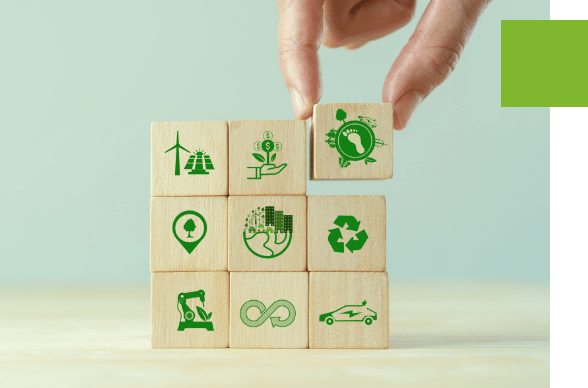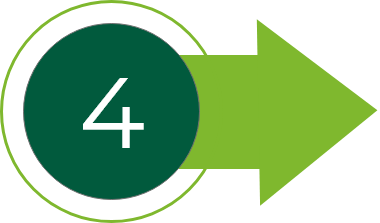Life Cycle Assessment
Calculate the impact of your product or service on the environment. Contact usImpact and footprint
Measure the sustainability of your project
Do you want to know the environmental footprint of your product? Or are you in doubt about the sustainability of raw materials for a new project? If you want to know and improve the environmental impact of your project, product or service, you need a Life Cycle Assessment (LCA). Our environmental experts can calculate the environmental impact of your product or service, providing you with insights on various environmental categories across (a part of) the value chain and enabling identification of hotspots for innovation.
The European Union identifies LCA as the best framework for assessing environmental impacts. For various European and national applications (some form of) LCA is already being used as foundation.
Uses and benefits
What are the benefits of a Life Cycle Assessment?
By gaining knowledge and insights of the impact on the environment of your product or service, an LCA provides opportunities in various areas. For example, think of:
Using a LCA to support different types of applications, such as Horizon Europe, the CSR Performance Ladder, Innovation Fund, LIFE and the Environmental Investment Allowance (MIA). Using our expertise within the financing landscape, we can find a good match with programs for your LCA.
Get a tangible indication of the sustainability of your product or service, which you can then communicate to your customer.
Utilize the LCA for attaining a green label or Environmental Product Certification (EPD), or to have your product included in an environmental database - like the Dutch National Environmental Database (NMD).
Identifying hotspots for innovation in the entire chain or within your own processes.
Provide insight into the impact of your product or service on the environment, thereby contributing to more efficient product development.
Use a comparative Life Cycle Assessment to compare the environmental impacts of different products and services.
Provide support in strategic and sustainable decision making. Our experts are aware of all current sustainability themes and are happy to assist you.
Use LCA as a basis for developing a product or material passport, such as the Digital Product Passport (DPP).


Curious about the benefits of a Life Cycle Assessment for your project? Contact us for a free consultation.
Our Approach
How does a Life Cycle Assessment work?
- Goal and scope definition
- Inventory analysis (LCI)
- Impact assessment (LCIA)
- Interpretation and implications of the data.
Our approach
How does a Life Cycle Assessment work?
We perform a life cycle assessment based on the ISO 14040 framework. ISO 14040 defines the principles and frameworks to perform a correct LCA. We go through four phases with every analysis:


Scoping
Determining the scope of the analysis in terms of project scope, methodological considerations and (potential) reference case.


Inventory
Gathering all the relevant data for the analysis.


Quantification
Quantifying and calculating the actual impact of the project.


Implementation
Drafting the conclusions and implications based on the results of the quantification phase.
1. Scoping
Determining the scope of the analysis in terms of project scope, methodological considerations and (potential) reference case.
2. Inventory
Gathering all the relevant data for the analysis.
3. Quantification
Quantifying and calculating the actual impact of the project.
4. Implementation
Drafting the conclusions and implications based on the results of the quantification phase.


Global network
Expert Support Databases
For these analyses, it is essential to use reliable data that accurately reflects state-of-the-art practices. EGEN has up-to-date software (OpenLCA) and access to a large recognized database (EcoInvent) to perform the Life Cycle Analysis. In this way, you are always assured of calculations that are supported by recognized environmental data from all over the world.
Green Procurement
Environmental Cost Indicator (ECI)
Circularity and green procurement are becoming increasingly important. The results of Life Cycle Assessments (LCA) are gradually being adopted for this purpose. LCAs are used increasingly in public procurement tenders, especially in the Dutch construction sector. The Environmental Cost Indicator (ECI) is used as an important criterion to determine the winning bid in tenders.
Supply Chain Transparancy
Material Passports
As sustainability continues to take center stage in global industries, the concept of material passports is becoming increasingly important. Material passports provide detailed information about the materials used in a product, supporting recycling and circular economy efforts. In this contex, the European Union wants to introduce the Digital Product Passport (DPP), a product passport that offers a comprehensive digital record of a product’s lifecycle, from raw materials to disposal, promoting transparency and sustainability throughout supply chains.
With potential legislation on the horizon that could mandate the use of DPPs, businesses need to be proactive. Incorporating Life Cycle Assessment (LCA) into your operations is a crucial step in preparing for these changes. LCA helps you understand and minimize the environmental impact of your products, and by including material and packaging data now, you can ensure compliance with future regulations.
Examples of
Projects with Life Cycle Assessments
Curious about the impact a Life Cycle Assessment can have on a project? Thanks to an LCA, these customers have been able to take the next step in their innovation process:
PROLIFEX
For this project, EGEN performed a CBA and an LCA. With the LCA, Prolifex was able to demonstrate the environmental improvement of the new recycling process compared to a reference scenario.


Short and informative
FAQ about LCA
What is a lifecycle assessment?
The LCA (Life Cycle Assessment or Life Cycle Analysis) is a method with which you map the influence of products, services or an activity on the environment. With calculation models we look at the complete life cycle of a product, a service or activity.
Why use a life cycle assessment?
The European Union sees the Life Cycle Assessment as the best framework for assessing environmental impacts to support the EU policy-making process and the ambitions of the Green Deal, among many other policy initiatives. For various European and national applications (a form of) LCA (The Product Environmental Footprint (PEF) and Organization Environmental Footprint (OEF)) is already being applied as support, service or activity.
How do you carry out a life cycle analysis?
We carry out a Life Cycle Assessment in accordance with the ISO 14040 standard. We go through the standardized four steps and work from the goal and scope definition of the analysis towards a interpretation. Contact us for more information about an assessment or request an LCA for your company.
What are examples of life cycle assessments?
You can find a Life Cycle Analysis in all layers of a company. Think of a partnership for EU projects, where potential partners for sustainability projects would like to find out more about the ecological footprint of your organization. But also, an HR department that wants to show candidates how sustainable the company is.
What are examples of impact categories?
There are many different and relevant environmental categories that can be measured using an LCA. For example, in addition to the impact of your product or service on climate change (in CO2-eq), LCA can also map the effect on acidification of soil and water, depletion of mineral and fossil raw materials, aquatic ecotoxicity, and air and water pollution. It is also possible to show the impact at a higher aggregation level, for example the effect on human health and biodiversity of your product and/or service. LCA thus provides a very broad representation of the environmental impact.
What is the difference between midpoint and endpoint impact categories?
Midpoint and endpoint impact categories represent different aggregation levels of impact for the environmental effect of your product or service. Midpoint impact categories focus on standalone environmental problems, for example climate change or acidification. Endpoint impact categories show the environmental impact at higher levels of aggregation, such as the effect on human health, biodiversity and resource scarcity.
INNOVATE TOGETHER
Wondering what we can do for you?
Contact us for advice without obligation.
Contact
Want to know more?
How can we help you? Contact us or send us a message for a swift reply.
Email
info@egen.green
Phonenumber
+31 (0)88 838 13 81
